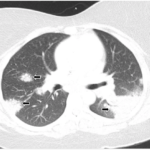The normal PET scan also ruled out a diagnosis of vasculitis involving large arteries such as the aorta. On the other hand, I seemed to recall, a normal PET scan is not sensitive enough to exclude vasculitis in the smaller arteries, particularly the arteries feeding the bowels, kidneys and liver. I wrote down: Vasculitis? Abdominal angiogram?
Before moving on, I reconsidered the original hematology opinion. It came early in the workup and considered Mrs. N’s anemia to be “the anemia of chronic disease.” Because this also fit with my impression, and the peripheral smear was unremarkable, a bone marrow aspiration and biopsy were not performed. On the other hand, here we were months into the illness and still without an answer. I wrote: Bone marrow? And circled it, twice.
Have we fully ruled out infection? I wondered. With its predilection for the joints and muscles, the Chikungunya virus can be an incapacitating illness, but it’s almost never seen in the United States. Hmm, this is interesting. I flipped back to the infectious disease consult; she had vacationed in Florida the week before she and her husband became ill. I wrote down draw Chikungunya serology, knowing full well this was a rheumatologic Hail Mary.
I tapped my fingers and looked at the clock. Still 20 minutes before my next patient.
Considering Connective Tissue Diseases and Miscellaneous, I closed my eyes and returned to the possibility of adult-onset Still’s disease, aware that occasionally the characteristic rash may begin many months into the illness. But five months? I ran my finger down the outpatient lab sheet and found a ferritin level that was minimally elevated. A repeat draw two months later: minimally elevated. Still’s disease without a rash or a sky-high ferritin level? No way. I crossed out Still’s disease.
Sarcoidosis? Again, I ran my finger down the list of outpatient and inpatient labs. An angiotensin-converting enzyme level, which is sometimes elevated with sarcoidosis, was in the normal range, times two. There was no typical lymph node enlargement on the chest, abdomen or pelvis CT scans. Sarcoidosis? I wrote it down, started to cross it out, and allowed it to remain.
My mind drifted to inflammatory myopathies—a family of immune system disorders targeting the muscles and joints. Even with normal proximal strength and a persistently normal CPK and aldolase? Yes, unlikely, but still on the list. I circled the words, schedule MRI of thigh. Myositis? and added: muscle biopsy if MRI positive.


